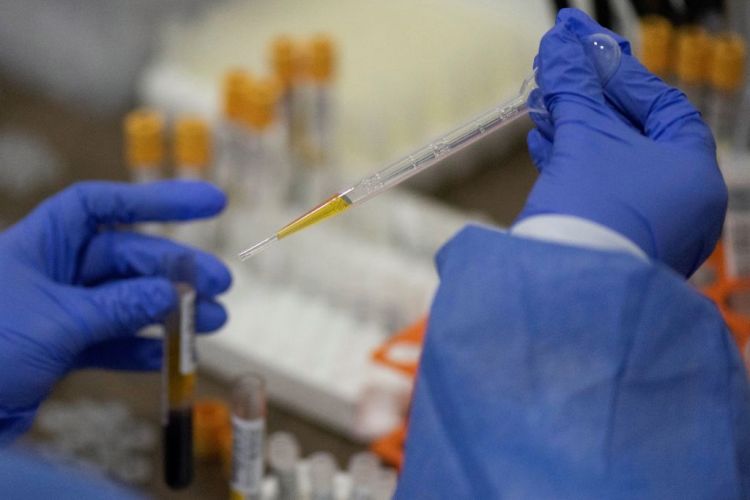强生公司“一剂式”新冠疫苗效果或超预期

在一项早期安全性研究中,强生公司(Johnson & Johnson)的实验性一剂式新冠疫苗产生了持久的免疫反应——我们或许得以窥见该公司疫苗在现实中的效果。据报道,强生新冠疫苗正逐渐接近美国监管机构的审批。
据媒体报道,该疫苗注射29天之内,有超过90%的受试者体内都形成了名为中和抗体的免疫蛋白,而57天内,所有受试者都形成了抗体。试验中,免疫反应的持续时间长达71天整。
1月12日,强生的首席科学官保罗•斯托菲尔斯在采访中说:“抗体的形成表明,已经有充分的希望和理由证明我们的疫苗将发挥作用。”等待该公司后期临床试验完成,结果很快就会汇报。
强生的一剂式新冠疫苗产生的中和抗体比其他两剂式先锋疫苗的其中一剂产生的抗体还要多。斯托菲尔斯表示,强生一剂式疫苗的效果,不比那些两剂式的竞争对手差。
1月13日,《新英格兰医学杂志》(New England Journal of Medicine)发表了这项1/2期试验的中期结果。该试验共有805名参与者,年龄均在18岁及以上。这些结果数据是对强生2020年9月首次公布的相对局限的研究结果的扩充。
1月13日盘后交易中,强生股价上涨了1.3%。而股市收盘后,Moderna公司(Moderna Inc.)股价下跌0.6%,此前,该公司生产的两剂式新冠疫苗已经被批准用于紧急使用。
强生公司的疫苗进展受到顶级传染病专家的密切关注——原因是,强生的疫苗有可能成为市面上第一种只需注射一针就能够提供保护的新冠疫苗,大规模疫苗接种工作由此变得更加容易。强生预计,下月初将获得最终阶段研究的确切疗效数据,疫苗有可能在3月获得监管批准。
目前,美国已经批准了两种疫苗的紧急使用许可:一种由辉瑞公司(Pfizer Inc.)及其合作伙伴BioNTech开发,另一种由Moderna公司开发——两种疫苗都采用了此前从未获批用于产品的mRNA技术。两家公司的疫苗对新冠病毒的有效率均超过了90%。
结果比预期要好。美国政府官员在早些时候曾经表示,任何有效性超过50%的疫苗都会被认为是成功的疫苗。在这一指引之下,强生的目标是60%的有效性,但斯托菲尔斯称,“我们希望并计划(有效性)达到70%”。
在未来几周内,强生公司将持续关注其疫苗在45000名志愿者参与的后期试验中的表现情况。斯托菲尔斯认为,根据早期研究结果及其他因素,疫苗的有效性有可能超过70%。
他表示,将强生疫苗的抗体反应与其他已经通过最后阶段试验的疫苗进行比较,“完全有理由相信强生疫苗将达到一个极高的有效性。90%以上?还不好说。等待数据告诉我们答案吧。”
1月13日,负责疫苗研发及分发的美国“曲速行动”(Operation Warp Speed)的首席科学顾问蒙塞夫•斯劳伊表示,他预计强生的一剂式疫苗有效性将达到80%至85%。为防止舞弊,强生及其政府合作者暂时无法得到具体数据。
专家表示,一剂式疫苗有着便于分发和管理的优势。Moderna、阿斯利康(AstraZeneca Plc)、辉瑞-BioNTech的疫苗都是两剂式,意味着需要二次运输,诊所也需要二次安排注射。并且Moderna和辉瑞-BioNTech的疫苗都需要极低温的储存环境,而强生的疫苗只需要在冰箱温度的条件下就可以存放三个月之久。
斯托菲尔斯说:“单剂疫苗会更加有效。我们对疫苗的效果非常有信心。”但同时,强生公司还在进行另外一项疫苗试验,将为我们“提供后备疫苗”。
1月13日公布的研究结果还发现,如果在两个月之后继续注射第二剂强生疫苗,中和抗体数量将增加三倍。斯托菲尔斯表示,这是一个积极的消息——因为强生仍然在评估一剂式疫苗的免疫持续时间,以及是否需要更高的抗体水平来对抗新的毒株。
强生公司于2020年11月启动了其两剂疫苗方案的后期研究。斯托菲尔斯称,强生或将在第一季度结束前(可能是3月或4月)完成30000名参与者的注册工作,预计数据将在夏季公布。
强生公司的候选疫苗由一种名为腺病毒的感冒病毒制成。这种病毒经过修改后能够复制冠状病毒的刺突蛋白,而病原体正是利用刺突蛋白进入细胞的。
虽然修改后的病毒不能在人体中复制,但会引发一种免疫反应,让身体为真正的新冠病毒入侵做好准备。这一种方法最初由哈佛大学(Harvard University)的研究人员共同开发,他们花了数年时间研究腺病毒平台,此前也曾经用于强生的埃博拉疫苗、寨卡病毒、呼吸道合胞病毒(RSV)和艾滋病毒候选疫苗的研究。
《新英格兰医学杂志》的报告显示,该疫苗在研究参与者中具有良好的耐受性。年轻人和老年人的免疫反应没有差异——这一点很关键,因为老年人最容易成为新冠肺炎患者。该疫苗最常见的副作用为发热、疲劳、头痛、肌肉疼痛和注射部位疼痛。(财富中文网)
编译:杨二一
在一项早期安全性研究中,强生公司(Johnson & Johnson)的实验性一剂式新冠疫苗产生了持久的免疫反应——我们或许得以窥见该公司疫苗在现实中的效果。据报道,强生新冠疫苗正逐渐接近美国监管机构的审批。
据媒体报道,该疫苗注射29天之内,有超过90%的受试者体内都形成了名为中和抗体的免疫蛋白,而57天内,所有受试者都形成了抗体。试验中,免疫反应的持续时间长达71天整。
1月12日,强生的首席科学官保罗•斯托菲尔斯在采访中说:“抗体的形成表明,已经有充分的希望和理由证明我们的疫苗将发挥作用。”等待该公司后期临床试验完成,结果很快就会汇报。
强生的一剂式新冠疫苗产生的中和抗体比其他两剂式先锋疫苗的其中一剂产生的抗体还要多。斯托菲尔斯表示,强生一剂式疫苗的效果,不比那些两剂式的竞争对手差。
1月13日,《新英格兰医学杂志》(New England Journal of Medicine)发表了这项1/2期试验的中期结果。该试验共有805名参与者,年龄均在18岁及以上。这些结果数据是对强生2020年9月首次公布的相对局限的研究结果的扩充。
1月13日盘后交易中,强生股价上涨了1.3%。而股市收盘后,Moderna公司(Moderna Inc.)股价下跌0.6%,此前,该公司生产的两剂式新冠疫苗已经被批准用于紧急使用。
强生公司的疫苗进展受到顶级传染病专家的密切关注——原因是,强生的疫苗有可能成为市面上第一种只需注射一针就能够提供保护的新冠疫苗,大规模疫苗接种工作由此变得更加容易。强生预计,下月初将获得最终阶段研究的确切疗效数据,疫苗有可能在3月获得监管批准。
目前,美国已经批准了两种疫苗的紧急使用许可:一种由辉瑞公司(Pfizer Inc.)及其合作伙伴BioNTech开发,另一种由Moderna公司开发——两种疫苗都采用了此前从未获批用于产品的mRNA技术。两家公司的疫苗对新冠病毒的有效率均超过了90%。
结果比预期要好。美国政府官员在早些时候曾经表示,任何有效性超过50%的疫苗都会被认为是成功的疫苗。在这一指引之下,强生的目标是60%的有效性,但斯托菲尔斯称,“我们希望并计划(有效性)达到70%”。
在未来几周内,强生公司将持续关注其疫苗在45000名志愿者参与的后期试验中的表现情况。斯托菲尔斯认为,根据早期研究结果及其他因素,疫苗的有效性有可能超过70%。
他表示,将强生疫苗的抗体反应与其他已经通过最后阶段试验的疫苗进行比较,“完全有理由相信强生疫苗将达到一个极高的有效性。90%以上?还不好说。等待数据告诉我们答案吧。”
1月13日,负责疫苗研发及分发的美国“曲速行动”(Operation Warp Speed)的首席科学顾问蒙塞夫•斯劳伊表示,他预计强生的一剂式疫苗有效性将达到80%至85%。为防止舞弊,强生及其政府合作者暂时无法得到具体数据。
专家表示,一剂式疫苗有着便于分发和管理的优势。Moderna、阿斯利康(AstraZeneca Plc)、辉瑞-BioNTech的疫苗都是两剂式,意味着需要二次运输,诊所也需要二次安排注射。并且Moderna和辉瑞-BioNTech的疫苗都需要极低温的储存环境,而强生的疫苗只需要在冰箱温度的条件下就可以存放三个月之久。
斯托菲尔斯说:“单剂疫苗会更加有效。我们对疫苗的效果非常有信心。”但同时,强生公司还在进行另外一项疫苗试验,将为我们“提供后备疫苗”。
1月13日公布的研究结果还发现,如果在两个月之后继续注射第二剂强生疫苗,中和抗体数量将增加三倍。斯托菲尔斯表示,这是一个积极的消息——因为强生仍然在评估一剂式疫苗的免疫持续时间,以及是否需要更高的抗体水平来对抗新的毒株。
强生公司于2020年11月启动了其两剂疫苗方案的后期研究。斯托菲尔斯称,强生或将在第一季度结束前(可能是3月或4月)完成30000名参与者的注册工作,预计数据将在夏季公布。
强生公司的候选疫苗由一种名为腺病毒的感冒病毒制成。这种病毒经过修改后能够复制冠状病毒的刺突蛋白,而病原体正是利用刺突蛋白进入细胞的。
虽然修改后的病毒不能在人体中复制,但会引发一种免疫反应,让身体为真正的新冠病毒入侵做好准备。这一种方法最初由哈佛大学(Harvard University)的研究人员共同开发,他们花了数年时间研究腺病毒平台,此前也曾经用于强生的埃博拉疫苗、寨卡病毒、呼吸道合胞病毒(RSV)和艾滋病毒候选疫苗的研究。
《新英格兰医学杂志》的报告显示,该疫苗在研究参与者中具有良好的耐受性。年轻人和老年人的免疫反应没有差异——这一点很关键,因为老年人最容易成为新冠肺炎患者。该疫苗最常见的副作用为发热、疲劳、头痛、肌肉疼痛和注射部位疼痛。(财富中文网)
编译:杨二一
Johnson & Johnson’s experimental one-shot COVID-19 vaccine generated a long-lasting immune response in an early safety study, providing a glimpse at how it will perform in the real world as the company inches closer to approaching U.S. regulators for clearance.
More than 90% of participants made immune proteins, called neutralizing antibodies, within 29 days after receiving the shot, according to the report, and all participants formed the antibodies within 57 days. The immune response lasted for the full 71 days of the trial.
“Looking at the antibodies, there should be good hope and good reason that the vaccine will work,” in the company’s late-stage clinical trial that’s soon to report results, J&J Chief Scientific Officer Paul Stoffels said on January 12 in an interview.
The one-shot vaccine generates more neutralizing antibodies than a single dose of other front-runner COVID-19 vaccine, all of which are two-shot regimens. But when compared with two shots of these rivals, the response to J&J’s single shot is in the same range, Stoffels said.
Interim results from the phase 1/2 trial of 805 participants ages 18 and older were published on January 13 in the New England Journal of Medicine. The data expanded on more limited findings J&J first published in September.
Shares of J&J rose 1.3% in post-market trading on January 13. Moderna Inc., which makes a two-dose COVID vaccine that’s been authorized for emergency use, fell 0.6% after U.S. markets closed.
J&J's progress is being closely watched by top infectious disease experts because its vaccine has the potential to become the first that can protect people after just one shot, making mass-vaccination campaigns much easier. The company expects to get definitive efficacy data from a final-stage study by early next month, potentially leading to regulatory authorization by March.
The U.S. has granted emergency-use authorizations to two vaccines, one developed by Pfizer Inc. and its partner BioNTech SE, and the other by Moderna Inc. Both employ a technology called messenger RNA that has never before been used in an approved product, and each showed more than 90% efficacy against COVID-19 symptoms.
Those results were better than expected. U.S. government officials had earlier said any vaccine with greater than 50% efficacy would be considered a success. Based on that guidance, J&J aimed for 60% effectiveness, Stoffels said, but “we hoped and we planned for 70%.”
Within weeks, J&J will learn how its vaccine performed in a late-stage trial of 45,000 volunteers. Stoffels now thinks it has the potential to be even higher than 70% effective, based on the early-stage findings and other factors.
When the antibody response to J&J’s shot is compared to others that have been through final stage trials “there’s a good reason to believe we can get into very high levels of efficacy,” Stoffels said. “Will it be north of 90%? I don’t know. The data will tell us.”
Moncef Slaoui, the chief scientific adviser to the U.S.’s Operation Warp Speed vaccine development and distribution effort, said on January 13 that he anticipates J&J’s one-shot vaccine will show 80% to 85% effectiveness against COVID-19. J&J and its government partners can’t see the data for the time being, a standard measure to prevent bias.
Experts have said that a single-shot vaccine offers advantages: ease of distribution and administration. Vaccines from Moderna, AstraZeneca Plc, and the Pfizer-BioNTech partnership all require two shots, which means repeat shipping and clinic visits. While Moderna and Pfizer-BioNTech’s shots must be frozen, J&J’s shot can be stored at refrigerator temperatures for three months.
“A single dose is going to be so much more effective in the world,” Stoffels said. “We are very confident that it works,” but another trial J&J is conducting of its vaccine plus a booster shot “will give us a backup.”
The study released on January 13 also found that a second dose of J&J’s shot, administered two months later, led to a three-fold increase in neutralizing antibodies. Stoffels said that’s positive news, as the drugmaker is still evaluating how long immunity from the single-shot will last, and whether higher antibody levels will be needed to combat new strains of the virus.
J&J kicked off the separate late-stage study of its two-dose vaccine regimen in November. Stoffels said the company is likely to finish enrolling the 30,000 participants before the end of first quarter, likely in March or April, and expects a data readout come summer.
J&J’s vaccine candidate is made from a cold virus, called an adenovirus, that’s modified to make copies of the coronavirus’ spike protein, which the pathogen uses to enter cells.
Though the altered virus can’t replicate in humans, it induces an immune response that prepares the body for an actual COVID-19 infection. It was first developed with researchers at Harvard University who have spent years working on the adenovirus platform, which is also used in J&J’s Ebola vaccine, as well as its Zika, RSV, and HIV investigational vaccine candidates.
The NEJM report showed the vaccine was well-tolerated across the study participants. There was no difference in the immune response in younger participants and the elderly, which is important given older populations are most vulnerable to the disease. The most frequent side effects were fever, fatigue, headache, muscle pain and injection-site pain.













